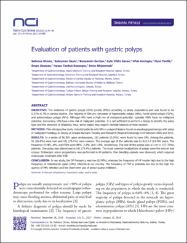Evaluation of patients with gastric polyps

View/
Access
info:eu-repo/semantics/openAccessDate
2018Author
Ölmez, ŞehmusSayar, Süleyman
Sarıtaş, Bünyamin
Savaş, Ayla Yıldız
Avcıoğlu, Ufuk
Tenlik, İlyas
Özaslan, Ersan
Köseoğlu, Hasan Tankut
Metadata
Show full item recordAbstract
OBJECTIVE: The incidence of gastric polyps (GPs) greatly differs according to study populations and was found to be 0.33%-6.7% in various studies. The majority of GPs are composed of hyperplastic polyps (HPs), fundic gland polyps (FGPs), and adenomatous polyps (APs). Although APs have a high risk of malignant potential, sporadic FGPs have no malignant potential. Conversely, HPs have a low risk of malignant potential. It is not sufficient to perform a biopsy to identify the polyp type and the presence of dysplasia; thus, some polyps may require multiple biopsies or total excision.
METHODS: This retrospective study included patients with GPs or polypoid lesions found on esophagogastroscopy with polyp or malignant histology on biopsy at Ankara Numune Training and Research Hospital Endoscopy Unit between 2005 and 2011.
RESULTS: In a series of 56.300 upper endoscopies, 192 patients (0.34%) were found to have GPs. Among the patients, 51 (26.6%) were men and 151 (73.4%) were women. The average age of the patients was 61.9 +/- 13.3 (14-90) years. The frequency of HPs, APs, and FGPs were 88%, 2.6%, and 1.6%, respectively. The size of the polyps was <= 1 cm in 137 (70%) patients. One polyp was determined in 141 (73.4%) patients. The most common localizations of polyps were the antrum and corpus. Endoscopic snare polypectomy was performed in 64 patients. One bleeding episode was observed, which required endoscopic treatment after ESP.
CONCLUSION: In our study, the GP frequency was low (0.34%), whereas the frequency of HP maybe high due to the high frequency of Helicobacter pylori (HPy) infection in our country. The frequency of FGP is probably low due to the high frequency of HPy infection and the short-term use of proton-pump inhibitors.

















